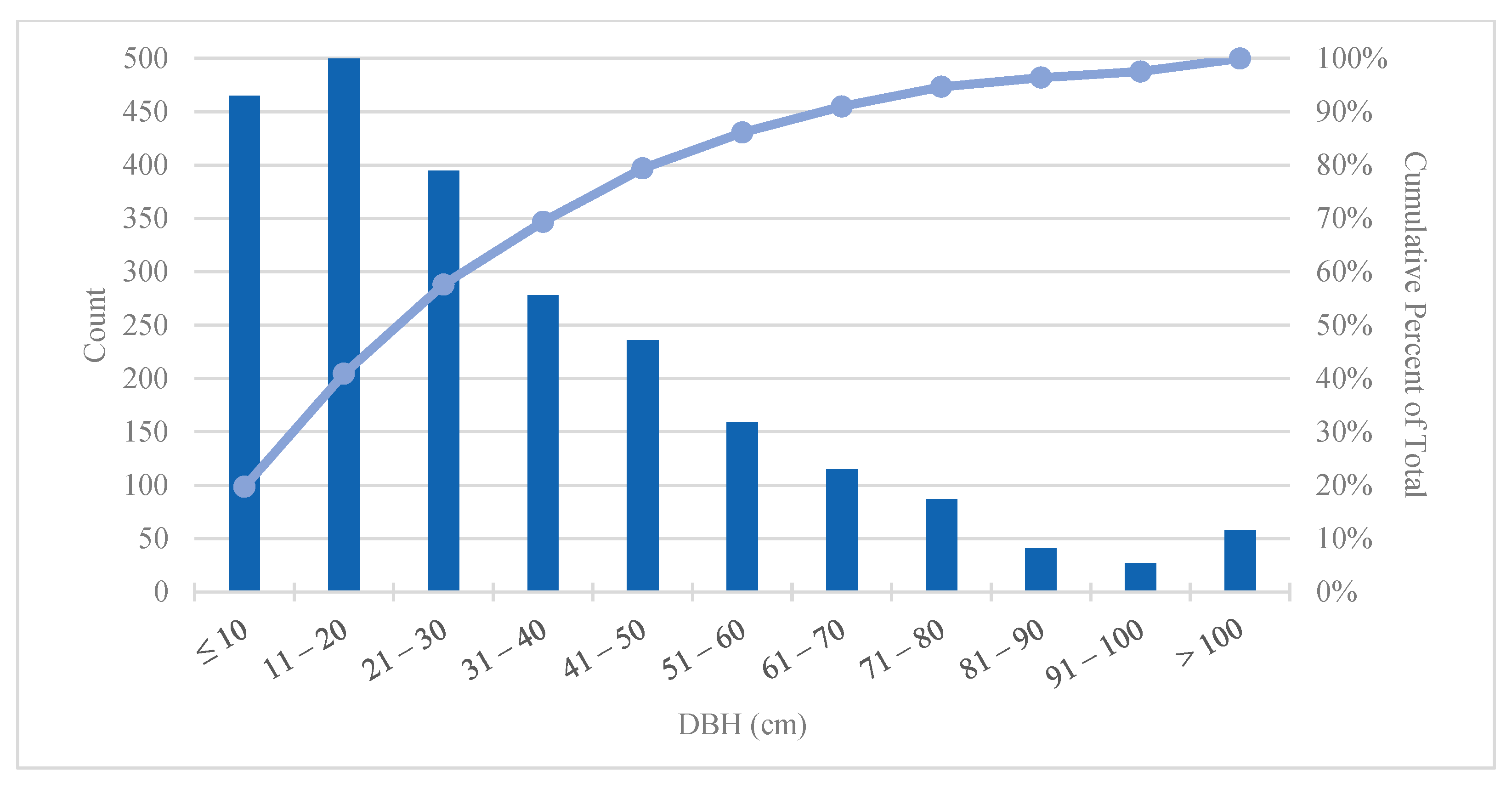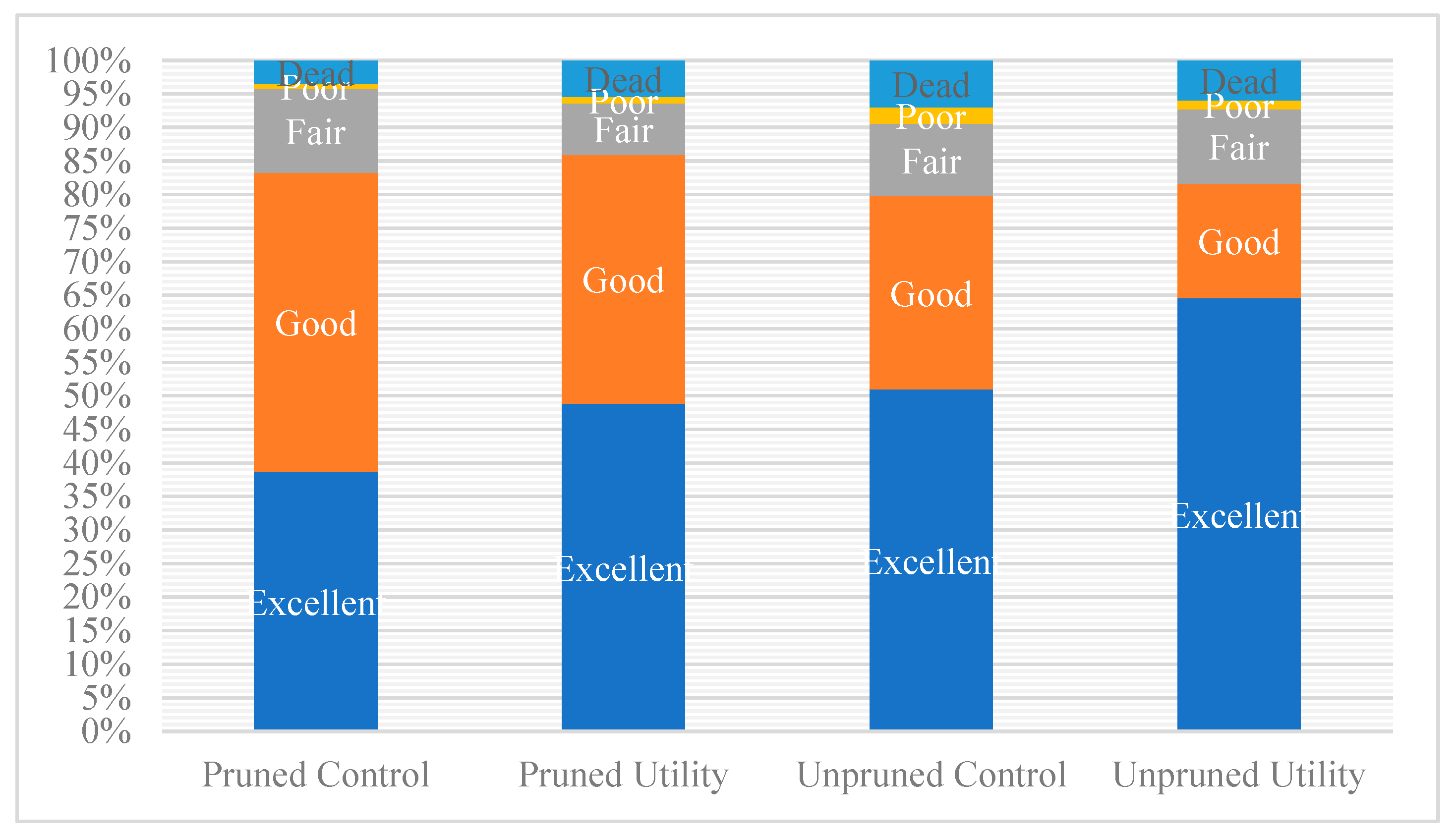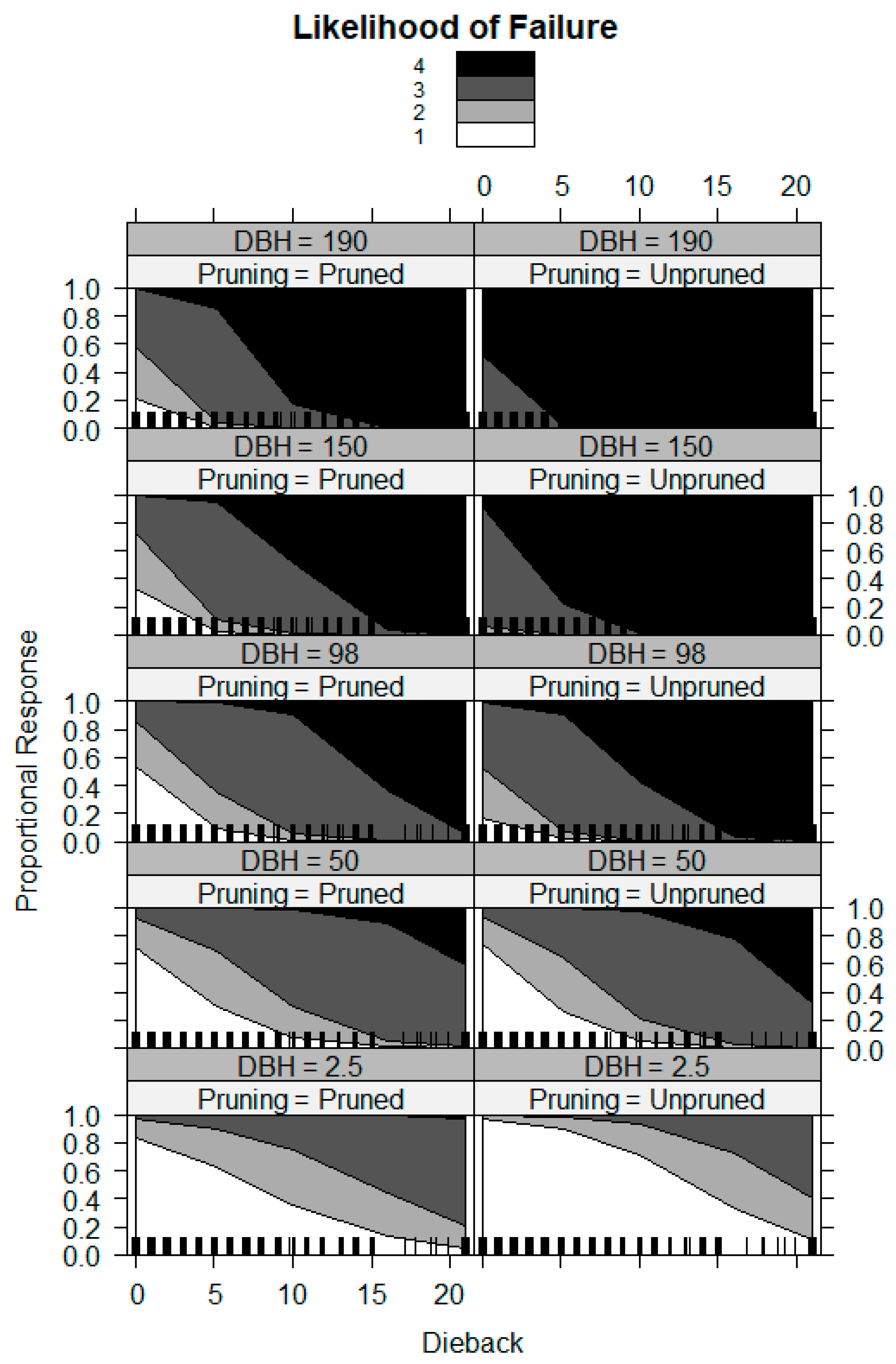Comparing the Structure, Function, Value, and Risk of Managed and Unmanaged Trees along Rights-of-Way and Streets in Massachusetts
Abstract
1. Introduction
2. Materials and Methods
3. Results
3.1. Tree Sample
3.2. Tree Size
3.3. Ecosystem Services and Values from i-Tree Eco
3.4. Likelihood of Tree Failure
4. Discussion
4.1. Tree Size and Delivery of Ecosystem Services
4.2. Likelihood of Failure
5. Conclusions
Supplementary Materials
Author Contributions
Funding
Data Availability Statement
Acknowledgments
Conflicts of Interest
References
- Livesly, S.J.; McPherson, E.G.; Calfapietra, C. The urban forest and ecosystem services: Impacts on urban water, heat, and pollution cycles at the tree, street, and city scale. J. Environ. Qual. 2016, 45, 119–124. [Google Scholar] [CrossRef] [PubMed]
- Simpson, P.; Van Bossuys, R. Tree-caused electric outages. J. Arboric. 1996, 22, 117–121. [Google Scholar] [CrossRef]
- Olienyk, D. The network between utility forestry and municipal forestry: It does exist. J. Arboric. 1988, 14, 265–268. [Google Scholar] [CrossRef]
- Vogt, J.; Hauer, R.J.; Fischer, B.C. The cost of maintaining and not maintaining the urban forest: A review of urban forestry and arboriculture literature. Arboric. Urban For. 2015, 41, 293–323. [Google Scholar] [CrossRef]
- Graziano, M.; Gunther, P.; Gallaher, A.; Carstensen, F.V.; Becker, B. The wider regional benefits of power grids improved resilience through tree-trimming operations evidences from Connecticut, USA. Energy Policy 2020, 138, 111293. [Google Scholar] [CrossRef]
- Ellison, M.J. Quantified tree risk assessment used in the management of amenity trees. J. Arboric. 2005, 31, 57–65. Available online: https://wwv.isa-arbor.com/store/product/442/ (accessed on 23 August 2022). [CrossRef]
- Goodfellow, J. Best Management Practices: Utility Tree Risk Assessment; International Society of Arboriculture: Atlanta, GA, USA, 2020. [Google Scholar]
- Smiley, E.T.; Matheny, N.; Lilly, S. Best Management Practices: Tree Risk Assessment, 2nd ed.; International Society of Arboriculture: Atlanta, GA, USA, 2017. [Google Scholar]
- Perry, P.B. Management’s view of the tree trimming budget. J. Arboric. 1977, 3, 157–160. [Google Scholar] [CrossRef]
- Dykes, A.M. Right-of-way management program. J. Arboric. 1980, 6, 74–76. [Google Scholar] [CrossRef]
- Kuntz, P.A.; Christie, R.D.; Venkata, S.S. Optimal vegetation maintenance scheduling of overhead electric power distribution systems. IEEE Trans. Power Deliv. 2002, 17, 1164–1169. [Google Scholar] [CrossRef]
- Dahle, A.G.; Holt, H.H.; Chaney, W.R.; Whalen, T.M.; Grabosky, J.; Cassens, D.L.; Gazo, R.; McKenzie, R.L.; Santini, J.B. Decay patterns in silver maple (Acer saccharinum) trees converted from roundovers to v-trims. Arboric. Urban For. 2006, 32, 260–264. [Google Scholar] [CrossRef]
- Dahle, A.G.; Holt, H.H.; Chaney, W.R.; Whalen, T.M.; Grabosky, J.; Cassens, D.L.; Gazo, R.; McKenzie, R.L.; Santini, J.B. Branch strength loss implications for silver maple (Acer saccharinum) converted from round-over to V-trim. Arboric. Urban For. 2006, 32, 148–154. [Google Scholar] [CrossRef]
- Nowak, D.J.; Crane, D.E.; Stevens, J.C. Air pollution removal by urban trees and shrubs in the United States. Urban For. Urban Green. 2006, 4, 115–123. [Google Scholar] [CrossRef]
- Coville, R.; Kruegler, J.; Selbig, W.; Hirabayashi, S.; Loheide, P., II; Avery, W.; Shuster, W.; Haefner, R.; Scharenbroch, B.; Endreny, T.; et al. Loss of street trees predicted to cause 6000 L/tree increase in leaf-on stormwater runoff for Great Lakes urban sewershed. Urban For. Urban Green. 2022, 74, 127649. [Google Scholar] [CrossRef]
- Horváthová, E.; Badura, T.; Duchková, H. The value of the shading function of trees: A replacement cost approach. Urban For. Urban Green. 2021, 62, 127166. [Google Scholar] [CrossRef]
- Armson, D.; Stringer, P.; Ennos, A.R. The effect of tree shade and grass on surface and global temperatures in an urban area. Urban For. Urban Green. 2012, 11, 41–49. [Google Scholar] [CrossRef]
- Sander, H.; Polasky, S.; Haight, R. The value of urban tree cover: A hedonic property price model in Ramsey and Dakota Counties, Minnesota, USA. Ecol. Econ. 2010, 69, 1646–1656. [Google Scholar] [CrossRef]
- Escobedo, F.J.; Adams, D.C.; Timilsina, N. Urban forest structure effects on property value. Ecosyst. Serv. 2015, 12, 209–217. [Google Scholar] [CrossRef]
- Lilly, S.; Gilman, E.F.; Smiley, E. Best Management Practices: Pruning, 3rd ed.; International Society of Arboriculture: Atlanta, GA, USA, 2019. [Google Scholar]
- Gilman, E.F. An Illustrated Guide to Pruning, 3rd ed.; Cengage Learning: Boston, MA, USA, 2011. [Google Scholar]
- Dujesiefken, D.; Stobbe, H. The Hamburg Tree Pruning System–A framework for pruning of individual trees. Urban For. Urban Green. 2002, 1, 75–82. [Google Scholar] [CrossRef][Green Version]
- Ow, L.F.; Subhadip, G.; Koon Sim, E. Mechanical injury and occlusion: An urban, tropical perspective. Urban For. Urban Green. 2013, 12, 255–261. [Google Scholar] [CrossRef]
- Fini, A.; Frangi, P.; Faoro, M.; Piatti, R.; Amoroso, G.; Ferrini, F. Effects of different pruning methods on urban tree species: A four-year-experiment scaling down from the whole tree to the chloroplasts. Urban For. Urban Green. 2015, 14, 664–674. [Google Scholar] [CrossRef]
- Millet, J.; Bouchard, A. Architecture of silver maple and its response to pruning near the power distribution network. Can. J. For. Res. 2003, 33, 726–739. [Google Scholar] [CrossRef]
- Perette, G.; Delagrange, S.; Messier, C. Optimizing reduction pruning of trees under electrical lines: The influence of intensity and season of pruning on epicormic branch growth and wound compartmentalization. Arboric. Urban For. 2020, 46, 265–268. [Google Scholar] [CrossRef]
- Perette, G.; Delagrange, S.; Ramirez, J.A.; Messier, C. Optimizing reduction pruning of trees under electrical lines: The influence of tree vitality before pruning on traumatic responses. Urban For. Urban Green. 2021, 2021, 127139. [Google Scholar] [CrossRef]
- Nowak, D.J. Assessing the benefits and economic values of trees. In Routledge Handbook of Urban Forestry; Ferrini, F., van den Bosch, K., Fini, A., Eds.; Routledge: New York, NY, USA, 2017; pp. 152–163. [Google Scholar]
- Li, G.; Zhang, P.; Luh, P.B.; Li, W.; Bie, Z.; Serna, C.; Zhao, Z. Risk analysis for distribution systems in the northeast U.S. under wind storms. IEEE 2014, 29, 889–898. [Google Scholar] [CrossRef]
- MassGIS. Available online: https://www.mass.gov/info-details/massgis-data-2010-us-census (accessed on 23 August 2022).
- ArcGIS. Available online: https://desktop.arcgis.com/en/arcmap/latest/tools/data-management-toolbox/how-create-random-points-works.htm (accessed on 23 August 2022).
- USDA Forest Service. i-Tree Eco Users Manual, v6.0.; USDA Forest Service: Washington, DC, USA, 2020. [Google Scholar]
- i-Tree. Available online: https://www.itreetools.org/tools/i-tree-eco (accessed on 23 August 2022).
- The R Project for Statistical Computing. Available online: https://www.r-project.org/ (accessed on 23 August 2022).
- Mahan, C.G.; Ross, B.D.; Yahner, R.T. The effects of integrated vegetation management on richness of native compatible flowering plants and abundance of noncompatible tree species on a right-of-way in central Pennsylvania, USA. Arboric. Urban For. 2020, 46, 395–401. [Google Scholar] [CrossRef]
- Gilman, E.F.; Grabosky, J.C. Growth partitioning three years following structural pruning of Quercus virginiana. Arboric. Urban For. 2009, 35, 281–286. [Google Scholar] [CrossRef]
- Kristoffersen, P.; Buhler, O.; Larsen, S.U.; Randrup, T.B. Growth of newly established Tilia platyphyllos ‘Rubra’ roadside trees in response to weed control and pruning. Arboric. Urban For. 2010, 36, 35–40. [Google Scholar] [CrossRef]
- Gilman, E.F. Pruning Acer rubrum at planting impacts structure and growth after three growing seasons. Arboric. Urban For. 2015, 41, 11–17. [Google Scholar] [CrossRef]
- Gilman, E.F. Pruning severity and crown position influence aspect ratio change. Arboric. Urban For. 2015, 41, 69–74. [Google Scholar] [CrossRef]
- Clair-Maczulajtys, D.; Le Disquet, I.; Bory, G. Pruning stress changes in the tree physiology and their effects on tree health. Acta Hortic. 1999, 496, 317–324. [Google Scholar] [CrossRef]
- Víquez, E.; Pérez, D. Effect of pruning on tree growth, yield, and wood properties of Tectona grandis plantations in Costa Rica. Silva Fenn. 2005, 39, 381–390. [Google Scholar] [CrossRef]
- Findlay, C.; Last, F.; Aspinall, P.; Ward Thompson, C.; Rudd, N. Root and shoot pruning in root-balled Acer platanoides L.: Effects of establishment and shoot architecture. Arboric. J. 1997, 21, 215–229. [Google Scholar] [CrossRef]
- Hauer, R.; Peterson, W. Municipal tree care and management in the United States. In Proceedings of the International Society of Arboriculture Annual Conference and Trade Show, Orlando, FL, USA, 6–12 August 2015. [Google Scholar]
- Nowak, D.J. Understanding i-Tree: Summary of Programs and Methods; USDA Forest Service Northern Research Station: Madison, WI, USA, 2020. [Google Scholar]
- Koeser, A.K.; Smiley, E.T.; Hauer, R.J.; Kane, B.; Klein, R.W.; Landry, S.M.; Sherwood, M. Can professionals gauge likelihood of failure? Insights from tropical storm Matthew. Urban For. Urban Green. 2020, 52, 126701. [Google Scholar] [CrossRef]
- Gibbs, J.N.; Grieg, J.W. Survey of parkland trees after the great storm of October 16, 1987. Int. J. Urban For. 1990, 14, 321–347. [Google Scholar] [CrossRef]
- Duryea, M.L.; Blakeslee, G.M.; Hubbard, W.G.; Vasquez, R.A. Wind and trees: A survey of homeowners after Hurricane Andrew. J. Arboric. 1996, 22, 44–50. [Google Scholar] [CrossRef]
- Kane, B. Tree failure following a windstorm in Brewster, Massachusetts, USA. Urban For. Urban Green. 2008, 7, 14–23. [Google Scholar] [CrossRef]
- Nelson, M.F.; Klein, R.W.; Koeser, A.K.; Landry, S.M.; Kane, B. The Impact of Visual Defects and Neighboring Trees on Wind-Related Tree Failures. Forests 2022, 13, 978. [Google Scholar] [CrossRef]
- Klein, R.W.; Koeser, A.K.; Kane, B.; Landry, S.M.; Shields, H.; Lloyd, S.; Hansen, G. Evaluating the likelihood of tree failure in Naples, Florida (United States) following Hurricane Irma. Forests 2020, 11, 485. [Google Scholar] [CrossRef]
- Smiley, E.T.; Kane, B. The effects of pruning type on wind loading of acer rubrum. Arboric. Urban For. 2006, 32, 33–40. [Google Scholar] [CrossRef]
- Pavlis, M.; Kane, B.; Harris, J.R.; Seiler, J.R. The effects of pruning on drag and bending moment of shade trees. Arboric. Urban For. 2008, 34, 207–215. [Google Scholar] [CrossRef]
- DiFalco, S.; Morzillo, A.T. Comparison of attitudes towards roadside vegetation management across an exurban landscape. Land 2021, 10, 308. [Google Scholar] [CrossRef]





| Parameter | Level | n | p-Value | DBH (cm) | p-Value | Height (m) | p-Value | Crown Width (m) | p-Value | Crown Length (m) | p-Value | Crown Volume (m3) | p-Value | Percent Crown Missing |
|---|---|---|---|---|---|---|---|---|---|---|---|---|---|---|
| Plot type | <0.001 | 0.932 | <0.001 | <0.001 | <0.001 | <0.001 | ||||||||
| Control | 792 | 35 (1.05) a | 11.2 (0.22) a | 7.7 (0.17) a | 8.5 (0.13) a | 355 (14.0) a | 36.8 (1.05) a | |||||||
| Utility | 1569 | 31 (0.65) b | 10.9 (0.16) a | 6.9 (0.11) b | 7.9 (0.19) b | 241 (23.5) b | 50.0 (0.75) b | |||||||
| Pruning status | <0.001 | <0.001 | <0.001 | <0.001 | <0.001 | 0.006 | ||||||||
| Pruned | 1547 | 39 (0.71) a | 12.7 (0.16) a | 8.5 (0.11) a | 9.4 (0.13) a | 374 (17.1) a | 50.0 (0.70) a | |||||||
| Unpruned | 758 | 18 (0.65) b | 7.4 (0.18) b | 4.6 (0.10) b | 5.4 (0.14) b | 84.2 (8.75) b | 39.6 (1.20) b | |||||||
| Plot * Pruning | <0.001 | <0.001 | <0.001 | <0.001 | <0.001 | <0.001 | ||||||||
| Control Pruned | 401 | 46 (1.58) a | 12.8 (0.28) a | 9.8 (0.24) a | 9.9 (0.25) a | 549 (39.2) a | 34.6 (1.30) a | |||||||
| Control Unpruned | 371 | 23 (1.07) b | 9.5 (0.32) b | 5.4 (0.18) b | 6.9 (0.25) b | 139 (17.3) b | 40.0 (1.70) b | |||||||
| Utility Pruned | 1146 | 37 (0.77) c | 12.7 (0.19) a | 8.0 (0.13) c | 9.2 (0.15) c | 311 (18.1) c | 55.0 (0.80) c | |||||||
| Utility Unpruned | 387 | 13 (0.66) d | 5.4 (0.11) c | 3.8 (0.09) d | 3.9 (0.11) d | 32.6 (2.77) d | 39.1 (1.70) ab |
| Parameter | Level | p-Value | Carbon Storage (kg) | p-Value | Annual Carbon Sequestration (kg) | p-Value | Annual Runoff Avoided (m3) | p-Value | Annual Air Pollution Removed (g) | p-Value | Value of Annual Ecosystem Services ($) | p-Value | Structural Value ($) |
|---|---|---|---|---|---|---|---|---|---|---|---|---|---|
| Plot type | <0.001 | <0.001 | <0.001 | <0.001 | <0.001 | <0.001 | |||||||
| Control | 456 (31) a | 12.8 (0.58) a | 1.06 (0.05) a | 136 (5.88) a | 5.65 (0.28) a | 1850.58 (90.92) a | |||||||
| Utility | 352 (17) b | 10.8 (0.35) b | 0.80 (0.03) b | 103 (3.51) b | 4.18 (0.15) b | 1645.52 (53.44) b | |||||||
| Pruning status | <0.001 | <0.001 | <0.001 | <0.001 | <0.001 | <0.001 | |||||||
| Pruned | 524 (21) a | 14.9 (0.41) a | 1.12 (0.03) a | 142 (4.11) a | 5.99 (0.19) a | 2258.24 (63.04) a | |||||||
| Unpruned | 107 (11) b | 4.43 (0.27) b | 0.41 (0.03) b | 57.2 (3.21) b | 1.99 (0.12) b | 603.88 (36.16) b | |||||||
| Plot * Pruning | <0.001 | <0.001 | 0.061 | 0.129 | 0.205 | <0.001 | |||||||
| Control Pruned | 707 (53) a | 19.1 (0.91) a | 2793.25 (148.85) a | ||||||||||
| Control Unpruned | 184 (22) b | 5.96 (0.49) b | 831.68 (67.47) b | ||||||||||
| Utility Pruned | 460 (21) c | 13.5 (0.44) c | 2071.03 (66.47) c | ||||||||||
| Utility Unpruned | 33.0 (4.7) d | 2.97 (0.23) d | 385.50 (24.23) d |
| Effect | Likelihood Ratio | p-Value |
|---|---|---|
| Plot | 0.345 | 0.5566 |
| Pruning | 23.5 | <0.0001 |
| DBH | 6.12 | 0.0133 |
| Dieback | 9.50 | 0.0020 |
| Dieback * DBH | 5.11 | 0.0238 |
| Plot * DBH | 2.69 | 0.1010 |
| Plot * Dieback | 0.226 | 0.6344 |
| Plot * Pruning | 1.15 | 0.2839 |
| Pruning * DBH | 27.8 | <0.0001 |
| Pruning * Dieback | 2.07 | 0.1501 |
| Plot * Pruning * Dieback | 0.287 | 0.5923 |
| Plot * Pruning * DBH | 3.00 | 0.0830 |
| Plot * Dieback * DBH | 1.16 | 0.2815 |
| Pruning * Dieback * DBH | 1.71 | 0.1913 |
| Plot * Pruning * Dieback * DBH | 0.143 | 0.7054 |
| Effect | Coefficient (Std. Err.) | p-Value | Odds Ratio |
|---|---|---|---|
| Unpruned | −2.053 (0.260) | <0.001 | 0.13 |
| Dieback z | 0.216 (0.024) | <0.001 | 1.24 |
| DBH y | 0.016 (0.002) | <0.001 | 1.02 |
| Unpruned * Dieback | 0.046 (0.034) | 0.182 | 1.05 |
| Unpruned * DBH | 0.038 (0.007) | <0.001 | 1.04 |
| Dieback * DBH | 0.002 (0.001) | 0.001 | 1.00 |
| Unpruned * Dieback * DBH | 0.0003 (0.001) | 0.831 | 1.00 |
Publisher’s Note: MDPI stays neutral with regard to jurisdictional claims in published maps and institutional affiliations. |
© 2022 by the authors. Licensee MDPI, Basel, Switzerland. This article is an open access article distributed under the terms and conditions of the Creative Commons Attribution (CC BY) license (https://creativecommons.org/licenses/by/4.0/).
Share and Cite
Suttle, R.; Kane, B.; Bloniarz, D. Comparing the Structure, Function, Value, and Risk of Managed and Unmanaged Trees along Rights-of-Way and Streets in Massachusetts. Forests 2022, 13, 1602. https://doi.org/10.3390/f13101602
Suttle R, Kane B, Bloniarz D. Comparing the Structure, Function, Value, and Risk of Managed and Unmanaged Trees along Rights-of-Way and Streets in Massachusetts. Forests. 2022; 13(10):1602. https://doi.org/10.3390/f13101602
Chicago/Turabian StyleSuttle, Ryan, Brian Kane, and David Bloniarz. 2022. "Comparing the Structure, Function, Value, and Risk of Managed and Unmanaged Trees along Rights-of-Way and Streets in Massachusetts" Forests 13, no. 10: 1602. https://doi.org/10.3390/f13101602
APA StyleSuttle, R., Kane, B., & Bloniarz, D. (2022). Comparing the Structure, Function, Value, and Risk of Managed and Unmanaged Trees along Rights-of-Way and Streets in Massachusetts. Forests, 13(10), 1602. https://doi.org/10.3390/f13101602






